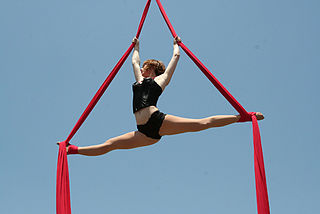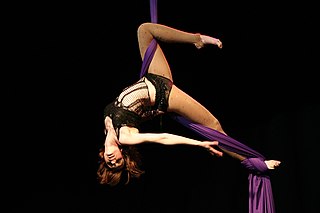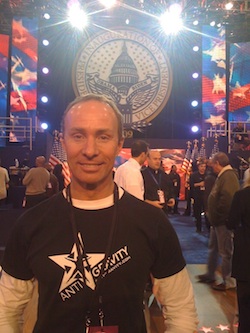
Choreography is the art or practice of designing sequences of movements of physical bodies in which motion or form or both are specified. Choreography may also refer to the design itself. A choreographer is one who creates choreographies by practising the art of choreography, a process known as choreographing. It most commonly refers to dance choreography.

Acrobatics is the performance of human feats of balance, agility, and motor coordination. Acrobatic skills are used in performing arts, sporting events, and martial arts. Extensive use of acrobatic skills are most often performed in acro dance, circus, gymnastics, and freerunning and to a lesser extent in other athletic activities including ballet, slacklining and diving. Although acrobatics is most commonly associated with human body performance, the term is used to describe other types of performance, such as aerobatics.

A trapeze is a short horizontal bar hung by ropes or metal straps from a ceiling support. It is an aerial apparatus commonly found in circus performances. Trapeze acts may be static, spinning, swinging or flying, and may be performed solo, double, triple or as a group act.

Deborah Colker is a Brazilian writer, theater director, dancer and choreographer. She was an awardee of the Laurence Olivier Award for Outstanding Achievement in Dance. Colker was also the movement director and choreographer of the 2016 Summer Olympics opening ceremony.

Aerial silks is a type of performance in which one or more artists perform aerial acrobatics while hanging from a specialist fabric. The fabric may be hung as two pieces, or a single piece, folded to make a loop, classified as hammock silks. Performers climb the suspended fabric without the use of safety lines and rely only on their training and skill to ensure safety. They use the fabric to wrap, suspend, drop, swing, and spiral their bodies into and out of various positions. The fabric may also be used to fly through the air, striking poses and figures. Some performers use rosin on their hands and feet to increase the friction and grip on the fabric. Aerial silks is a demanding art and requires a high degree of strength, power, flexibility, courage, stamina, and grace to practice.

The aerial hoop is a circular steel apparatus suspended from the ceiling, on which circus artists may perform aerial acrobatics. It can be used static, spinning, or swinging. Tricks that can be performed include the Candlestick, Bird's Nest and Crescent Moon
Aerial rigging is a specialty within the field of rigging that deals specifically with human loads. Aerial rigging is the process of setting up equipment used to make humans fly, specifically aerial circus and aerial dance equipment. The field is of critical importance, and a thorough grasp of the principles of aerial rigging is essential in order to ensure the safety of the artists and the audience.
The Ice Theatre of New York is a professional ensemble company dancing on ice, performing works by choreographers drawn from competitive figure skating and modern and contemporary dance. Aiming to create dance on ice as part of the modern performing arts scene, Ice Theatre of New York (ITNY) was first conceived by Marc Bogaerts, Marjorie Kouns, Cecily Morrow and Moira North. Moira North went on to found ITNY in 1984. North, a Canadian-born skater was twice named one of the 25 most influential names in figure skating by International Figure Skating Magazine. Based at the Chelsea Piers rink complex in New York City, Ice Theatre of New York was the first not-for-profit professional ice dance company in the U.S. and the first to receive funding from the National Endowment for the Arts, New York State Council on the Arts, and New York City Department of Cultural Affairs. Italian ice dancer, choreographer and aerialist, Elisa Angeli, is Ice Theatre of New York’s Ensemble Director.
Bandaloop, formerly Project Bandaloop and stylized as BANDALOOP, is an aerial dance company founded in 1991 by Amelia Rudolph. The company's incorporation of climbing technology allows dancers to execute routines on vertical surfaces and perform in public spaces.

Elizabeth Streb is an American choreographer, performer, and teacher of contemporary dance.

Paul Belville Taylor Jr. was an American dancer and choreographer. He was one of the last living members of the third generation of America's modern dance artists. He founded the Paul Taylor Dance Company in 1954 in New York City.

Zaia was a Cirque du Soleil stage production based at The Venetian Macao on the Cotai Strip in Macau. The 90-minute show opened in August 2008, bringing together 75 high-calibre artists from around the world. Zaia was Cirque du Soleil's first resident show in Asia and was directed by Neilson Vignola and Gilles Maheu. The custom-built theater housing the performance was capable of seating 1,800 spectators at a time.

Ovo is a touring circus production by Cirque du Soleil that premiered in Montréal, Canada in 2009. Ovo's creator and director, Deborah Colker, took inspiration from the world of insects. The idea for Ovo was not to be about the acts, nor dancing, nor insects, but about movement. The movement of life permeates the entire show, with creatures flying, leaping, bounding, and crawling. Composer Berna Ceppas brought additional life to Ovo with a score inspired by the music of Brazil. Ovo means "egg" in Portuguese and represents the underlying thread of the show. Graphically, inside the logo of Ovo, is an insect. The two O's represent the eyes and the V forms the nose and antennas.

Iris was a resident Cirque du Soleil show based in Los Angeles, California. It premiered on September 25, 2011, after preview performances which began on July 21, 2011. The cost for production of the show was nearly $100 million, which included the cost of renovating the Dolby Theatre in which the show was housed. Iris was written and directed by French director-choreographer Philippe Decouflé. The show explored images from the history of cinema and featured elaborate choreography, acrobatics, and a variety of contemporary circus acts. The name of the show, Iris, comes from the camera diaphragm as well as from the colored iris of the human eye.

Christopher Calvin Harrison is an American director, dancer, acrobat, choreographer, fitness professional, and founder of performance troupe AntiGravity, Inc. and its spin-off fitness brand, AntiGravity Fitness.

Sebastien Stella is a French choreographer and director. He is best known for creating aerial performance routines for singer Pink and devising the circus choreography for the 2010 American romantic drama film Water for Elephants.
Gregangelo's Velocity Circus/Arts and Entertainment is a San Francisco-based circus troupe and entertainment company that incorporates the arts, technology, astrophysical concepts, and cultural diversity into their performance acts. The circus and entertainment company was founded in 1993 by Artistic Director Gregangelo Herrera, a whirling dervish, aerial arts choreographer, and drummer. The company's signature performances incorporate multiculturalism, ensemble aerial acts, optical illusions, immersive entertainment, and interactive play. Operating both one-out events and a variety of immersive shows, the troupe and entertainment company create performances and experiences with a cast of local San Francisco and Bay Area artists, including several artists they have sponsored from around the world.
Terry Sendgraff is an American modern dancer and choreographer known as the founder of the Motivity dance method. She is often credited as being the founder of modern aerial dance.
Chisato Minamimura is a British dancer and choreographer. She is deaf and a British Sign Language user.

















